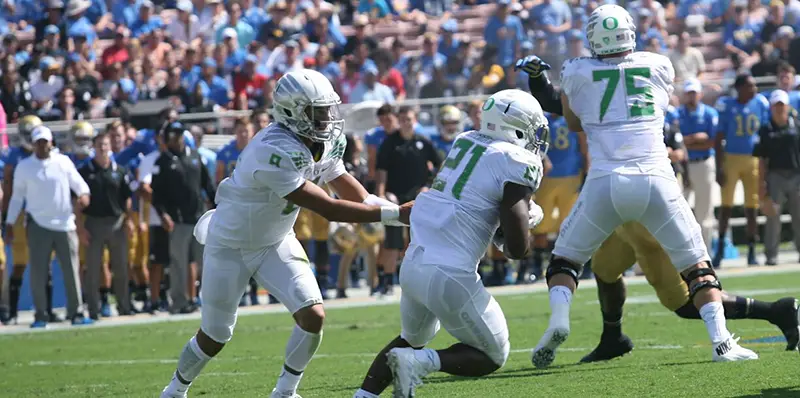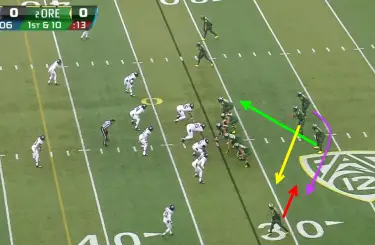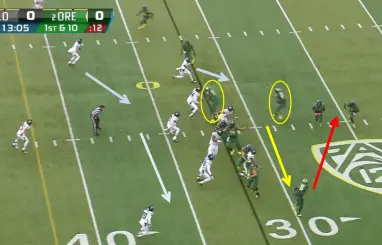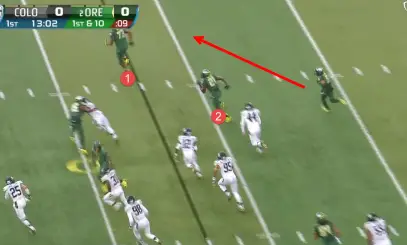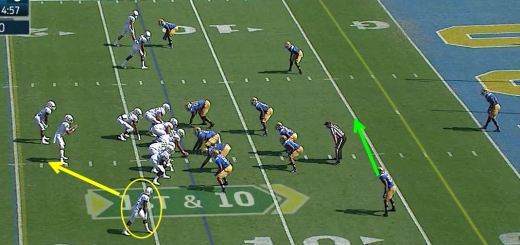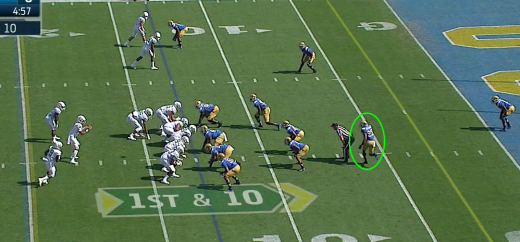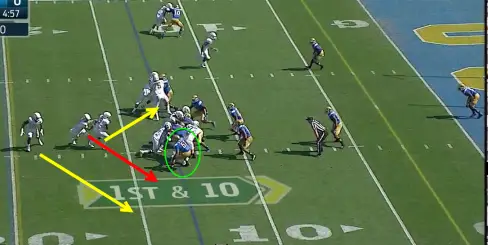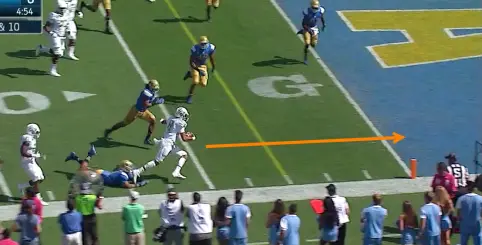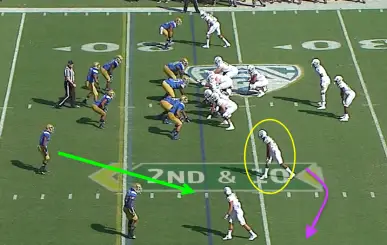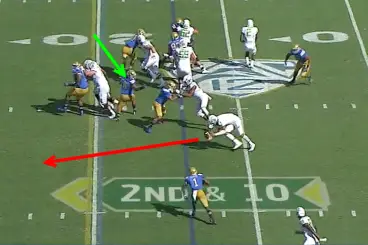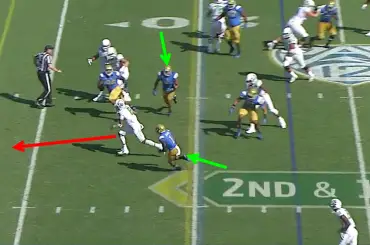Football is a game of position and space, and coaches spend a great deal of time analyzing their schemes to incorporate wrinkles and techniques that will influence the opposition. In most cases, causing a slight hesitation, or a few small steps in the wrong direction, can result in a big play. Option football, which includes the zone read, is predicated on this. As we have seen in recent years, Oregon is very good at utilizing the option concept to increase offensive productivity.
FishDuck.com has some of the best analysis on the web that examines Oregon’s offense. Here we add to this library of knowledge with an analysis of how the Ducks incorporate small and easily-implemented wrinkles into their option game to influence the defense. These wrinkles are effective in pulling defenders out of position and creating space for Oregon ball carriers to chew up massive amounts of yardage.
Example One — Option Reverse
Misdirection and reverse plays are common in offensive football, and the most effective ones are usually tied into the offense’s base plays. For Oregon, this means the zone read.
In the screen shot, above, we see Oregon aligned in a two-back set with three wide receivers (two at the top of the formation, one at the bottom). The initial action shows Oregon running their straddled triple option play. The wrinkle in this case, is the reverse. To set this up, Oregon has the receiver on the bottom of the screen (red arrow above) release into the backfield while the play fake takes place.
As the play develops, the general flow of the play is going to the offense’s left. This causes the defense to react in that direction. Take note of the the two circled players – they are setting themselves up to be lead blockers on the reverse. The offensive lineman uses a technique, which I call a “slam-slip” where he engages the defensive lineman for a second or two and then slips out to block in the flat area. The other lead blocker is the back coming off of the zone read fake.
As the reverse pitch is made to the receiver, above, the defense begins to notice the misdirection and attempts to recover. However, Oregon already has three available players in position to secure a running lane on the play side.

Using an option look to set up misdirection.
The result of this misdirection gives the receiver a clear running lane as he moves in behind the lead blockers. This results in a large positive gain for the offense. It has the added benefit of creating a scenario where defenders may likely react slower to future read option plays now that they have seen the reverse, giving the offense yet another advantage.
Example Two – Shifting to Gain Leverage
Another way to manipulate a defense into giving up space and leverage is shifting from one formation to another.
Above, Oregon is aligned in a three-wide set with a single back and a tight end aligned in a wing back position. As the play starts, the single receiver at the bottom of the formation shifts into the backfield, creating a two-back set with twin receivers at the top of the screen.
Above, the defender reacts to this shift by moving inside and vacating the flat area. Thus, the shift manipulated the defense into completely vacating nearly 1/3 of the football field.
As the play develops, the end man on the line of scrimmage (circled in green above) squeezes down to defend the inside zone, giving Marcus Mariota a pull-read. As he pulls, we can see that the vacated flat area is wide open, and there is still the possibility of a pitch if a defender shows up.
Above, the defense begins to redirect itself after realizing the quarterback still has the football. However, due to the initial shift followed by the inside zone read, the defender who started in the flat has come so far inside that he is almost in the middle of the field.
The vacated flat area (shown above) is wide open and the ball carrier has most of the area between the hash and the sideline to make something happen.

It is subtle, but creating space helps to score this TD.
In this case, as shown above, Mariota’s speed and quickness does the rest as he outruns the defense and puts six points on the board for the Ducks.
Example Three — Passing Off of the Option
Another powerful wrinkle in Oregon’s option packages is the ability to throw the ball after executing the zone read. While there are many variations of this concept, Oregon most often utilizes a swing route from an inside receiver to set up a screen option.
In the screenshot above, we see Oregon aligned in a three-wide set with a single back and a tight end lined up in the wing back position. This is a very similar set to the one we saw in the shift example above. Take note of the route run by the inside slot receiver at the bottom of the formation and the effect it has on the defender.
As the zone read occurs, the read key defender (circled in green above) squeezes down, giving Mariota a pull read. We also see the circled defender turn his shoulders and commit to the inside. On the perimeter the No. 2 receiver begins his swing route, which influences the defender to move into a position to defend the screen pass. On the bottom of the formation, the No. 1 receiver releases deep to run off the cornerback.
This action has influenced the UCLA defenders to vacate the area between the hashes completely (see red arrow above).
A brief fumble by Mariota allows the defense to recover slightly. However, the manipulation worked so well that Mariota was still able to capitalize on the play and find the end zone.

A clear-out big enough to overcome a fumble!
Wrapping it Up
Developing wrinkles that compliment your offensive scheme is a key aspect to football strategy. A well-designed play will not only gain yardage for the offense, but it will also work in tandem with other plays in your offense to manipulate and/or slow the defense’s reaction time. Any hesitation from the defense, especially for a team with Oregon’s speed, will lead to explosive plays and high level of offensive production.
I may be in New York, but oh, how we love to learn about your beloved Ducks!
Coach Levi Steier
Albany, NY
OptionFootball.net
Top Photo by David Pyles
Levi Steier, (Football Analyst) after a collegiate playing career cut short by injuries, began his coaching career as a student assistant at Dakota State University. Since then he has coached primarily at the high school level. During this time he has been a head coach and has coordinated all three phases of the game. He is currently the owner of a web design business and the publisher at OptionFootball.net where he discusses many aspects of football, but regularly focuses on option oriented football topics. Coach Steier enjoys talking football and encourages anyone who would like to discuss the game or find more information to visit his site. You can follow Levi on twitter @OptionFootball, on his Facebook page and on Google+.

